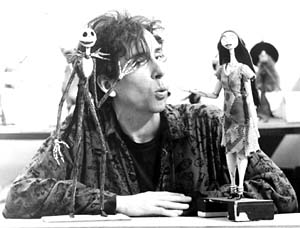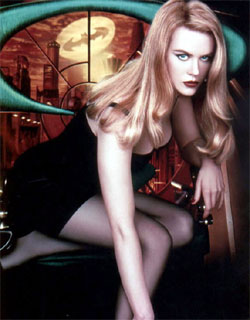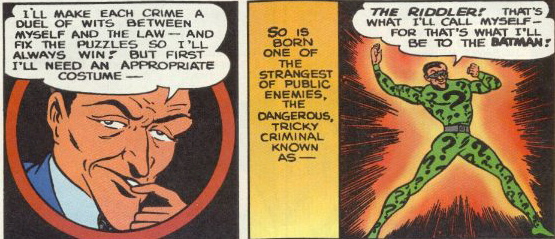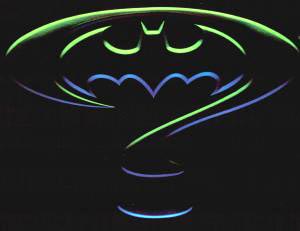PLEASE NOTE: This interview was originally posted on November 27, 2009 on the former Batman site Brother-Eye.net and has been moved here.
 |
It all started with Smoke and Mirrors.
Lee and Janet Scott Batchler were screenwriters looking to break into the industry and, after nine drafts, finally sent out their spec script, Smoke and Mirrors, to studios around town.
While Disney eventually bought the script, Warner Brothers was so impressed that they offered the Batchlers to write for their company's "most important corporate asset": Batman.
Ben Wan sat down with Janet Scott Batchler to discuss the development of the script, confirm and debunk old rumors, and uncover some little-known facts on the film.
MEETING TIM BURTON
Needless to say, there's been massive speculation around the Internet on how much involvement Tim Burton may have had in the third Batman film.
 |
The truth is that Burton was only around to approve his creative successors. After approving Joel Schumacher to take over as the director, Burton met with the Batchlers, who agreed with him that "the key element to Batman is his duality. And it's not just that Batman is Bruce Wayne. All the villains also have secret identities. Superman may be Clark Kent, but Lois Lane is always Lois Lane and Lex Luthor is always Lex Luthor.
And when we said that, Tim just kinda went, 'Yes!' And at that point, we pretty much had the job."
Tim Burton would go on to make Ed Wood as the Batchlers began work with Joel Schumacher.
COMIC BOOK RESEARCH
For research, the Batchlers read several comics, which, for Janet, was a visit to the past. "I had read Batman comics as a little girl, but stopped when I was at college. He was always the superhero that I related to as a kid. So, it was sort of fun to pick it up again."
When asked what brought her to the character, she shared, "Our local store didn't carry Wonder Woman. And I liked the character of Robin. The only people I knew named Robin were girls. So, right away, I felt allowed to be in this world because there's a character with a girl's name."
The Batchlers read the 1939-1940 comics by Bob Kane and Bill Finger, as well as some of the then-current Knightfall saga, to get a sense of what modern comic book fans were reading.
"We also read the Frank Miller graphic novels that were out." This is not surprising as Miller's The Dark Knight Returns was obviously influential for the film's flashback of Bruce's discovery of the cave. In fact, one of the early Batman Forever drafts faithfully adapted Miller's scene in which Bruce, before his parents' deaths, chases a rabbit on the Wayne Manor grounds, only to fall into the cave below.
In addition to the comics, the Batchlers read academic papers that provided psychoanalysis on Batman. This not only helped in understanding the character, but also could have helped provide a basis for writing Dr. Chase Meridian.
 |
CREATING CHASE MERIDIAN:
Unlike Vicki Vale and Catwoman in the previous films, Dr. Chase Meridian was a creation of the Batchlers, rather than an adaptation of a comic book character.
Mrs. Batchler revealed, "Because of our decision to focus very distinctly on the division between Bruce Wayne and Batman, it just came to us early on that perhaps the love interest for the movie could be a psychiatrist, who might be able to help him walk that dangerous line and keep him on an even keel -- hence the name 'Meridian'."
In terms of casting, she shared, "We didn't have anyone in mind when we first created her, but Nicole Kidman's name came up very early in our work, and we thought she was a great idea."
BRINGING IN THE RIDDLER:
"The studio insisted on having two villains after Batman Returns. Joel Schumacher chose Two-Face. He already knew he wanted Tommy Lee Jones. That was already a done deal. They were very open to any second villain that we would choose."
Due to the character's popularity, the Riddler was the obvious choice. "You're trying to make a big, pop tentpole movie. And we said, 'Look, we can't be using an obscure villain. We need a villain that everybody knows. And the villains that people know are The Joker, Catwoman, and the Riddler.' They had already done the Joker and already done Catwoman. So, we said we had to go with the Riddler."
In balancing Riddler with Two-Face, she admitted, "We didn't see a need for two villains. One good villain can drive a movie. So, we said, if you want two villains, we need two heroes and they split. We'll have one villain for Bruce Wayne and one villain for Batman. Tommy Lee Jones is already Batman's villain. So what can we do with the Riddler?" As such, the Batchlers created a new origin for the Riddler, giving the character a vendetta against Gotham's favorite son.
As proposed, the two villains challenged both sides of the Dark Knight, with Riddler as the intellectual villain for Bruce Wayne and Two-Face as the more physical villain for Batman. Batchler explained, "If you're going up against Bruce Wayne, muscle doesn't matter very much. You're gonna use tools of intellect and marketing. Businessmen's tools. Businessmen in general don't go out for lots of fighting. If you're the villain going up against Batman, you need to be on the physical side because Batman's on the physical side."
In the early drafts, the Riddler's real name was Lyle Heckendorf and his corrupt company was called HeckTech. One of the original ideas with Lyle that didn't make it into the movie was a scene at the circus where, in stalking Bruce, he knocks out a circus employee dressed up as a leprechaun. Lyle takes the leprechaun's clothes, which evolves into The Riddler's trademark look. In bringing up this origin scene, Mrs. Batchler revealed that director Joel Schumacher actually came up with the idea. "Joel started off as a costume designer. So costumes matter to him. He pays attention to them, while other directors might not."
For those curious in reading this older draft, you can access it online at this link: http://home.swipnet.se/~w-84328/scripts/bat.html
For casting, Mrs. Batchler confirmed that Robin Williams was Schumacher's original choice for the role. "We were sort of writing with him in mind. But it was a deal that couldn't be made." Eerily, Williams holds a very strong resemblance to how the Riddler was drawn by Dick Sprang and Charles Paris during his first appearance in Detective Comics #140 in 1948.

Along the same lines, everybody believed that Michael Keaton would continue as Batman. The Batchlers wrote the character with Keaton in mind and took the previous Tim Burton Batman films into account. But, like with Williams, no deal was agreed upon and Val Kilmer was hired to replace Keaton.
DEVELOPING ROBIN
On top of bringing in the new villains, Joel Schumacher wanted to bring in the character of Dick Grayson, a.k.a. Robin.
 |
Luckily, the Batchlers had the advantage of working with an assistant who grew up in the circus. "She was the elephant girl, but she could do all the aerial work. She took us to a couple of circuses. We absolutely picked her brain about life in the circus and as an aerialist. We asked - "How does it really work when you're up on the trapeze? How does it really work backstage??"
This research lead to one small difference between the comics and the film: in Batman Forever, Dick Grayson not only loses his parents, but also loses a brother. "If you're doing a trapeze act, you need more people. We needed to fill up the act."
The addition of Robin into the Batman mythology also allowed them to explore Bruce's character further. "The thing with the superhero is you don't really get much of an arc. 'Cause they always have to be back at the beginning for the next movie. If Batman ever really worked out all of his deep-seated psychological issues, he wouldn't be Batman anymore. He'd lead a healthy productive life as Bruce Wayne and not need to be Batman. So you can't go too far with a character arc. Robin gave us a chance to go a little bit because he was something utterly new coming into his life."
 |
WHY BATMAN FOREVER?:
Some fans have wondered what lead to the title Batman Forever. Perhaps it was due to Bruce Wayne's acceptance, in the film, that he will always be both Bruce Wayne and Batman forever? Or does it stem from the marketing's tag line, "Courage now, truth always, Batman Forever"?
Whatever the reason behind the title, the screenwriters could not take credit for it.
"We delivered all our work as Batman 3," said Mrs. Batchler. "We were not involved at all in the creation of the title."
FROM SCRIPT TO SCREEN:
After several revisions on the script, the Batchlers had to return to Disney. "[They] refused to let us go to Warner Brothers to work on Batman. So officially, we were working on Batman only during the meeting periods of our work for Disney." When the Batchlers left, Joel Schumacher then hired his collaborator, Akiva Goldsman, to continue working on the script.
Despite the addition of another writer, Mrs. Batchler explained, "Virtually everything we did made it into the final film. There were a lot of rewrites that were mainly production rewrites where tiny things changed. Most of what didn't make it into the film was not our work. And there were things that did make it into the film that were not our work."
On the other hand, there was one added scene, though, that Mrs. Batchler joined Batman fans in criticizing: "We did not write the Batmobile going up the side of the building. Because we have a philosophy on action sequences and that wouldn't have fit into it because nothing happens as a result of the action sequence. The plot is not changed because of it. It's just eye candy - very cool eye candy, but eye candy. Joel called us 'the logic police'. We would've been going, "Excuse me? How does he get down?!?"
WHAT'S NEXT FOR THE BATCHLERS:
When asked about her upcoming projects, Mrs. Batchler revealed that she and her husband are working with Fox on Pompeii, a film covering the historical destruction of the Roman city due to the volcano Mount Vesuvius. "It's two hours of high-level disaster. Any writing day where you get to kill 18,00 people in one day is good work".
In addition to that, she shared, "We're also working with a producer at Universal on a script that should be going out to directors soon."
EDITOR'S NOTE: Since the first publication of this interview, the project of Pompeii is now set for production in Spring 2012 with director Paul W.S. Anderson for Constantin Films. The Batchlers also sold a pitch recently to Disney for a movie covering Paul Revere's famous ride during the American Revolution.
Batman-Online.com wishes the Batchlers the best of luck on their upcoming projects and a heartfelt thanks for contributing to the Dark Knight's cinematic legacy.













by Silver Nemesis
by Silver Nemesis
by The Joker
by Gotham Knight
by thecolorsblend
by The Joker
by The Joker
by The Joker
by thecolorsblend
by Silver Nemesis